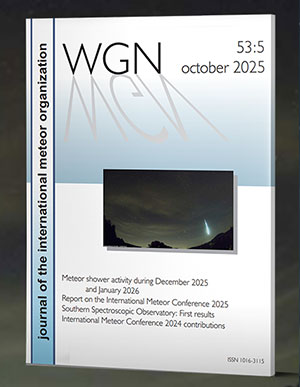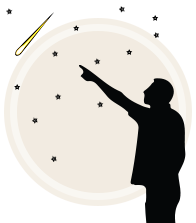As seen from the northern hemisphere, meteor rates
continue to be strong in November. While no major showers are active this month,
the two Taurid radiants plus the Leonids keep the skies active. The addition of
strong sporadic rates make November one of the better months to view meteor
activity from north of the equator. Skies are fairly quiet as seen from the
southern hemisphere this month. Activity from the three showers mentioned above
may be seen from south of the equator, but the sporadic rates are much lower than
those seen in the northern hemisphere.
During this period the moon reaches its first
quarter phase on Tuesday November 24th. On that date the moon lies ninety degrees
east of the sun and will set near midnight local standard time (LST). This weekend
the waxing crescent moon will set long before the more active morning hours arrive,
allowing dark skies for those who venture out during the morning hours. As the week
progresses the moon sets later each night narrowing the window of opportunity to
view under dark conditions. The estimated total hourly rates for evening observers
this week is near four as seen from the northern hemisphere and three from the
southern hemisphere. For morning observers the estimated total hourly rates should
be near twenty from the northern hemisphere and ten as seen from the southern
hemisphere. The actual rates will also depend on factors such as personal light and
motion perception, local weather conditions, alertness and experience in watching
meteor activity. Rates are reduced during the evening hours due to moonlight.
The radiant positions and rates listed below are exact
for Saturday night/Sunday morning November 21/22. These positions do not change
greatly day to day so the listed coordinates may be used during this entire period.
Most star atlases (available at science stores and planetariums) will provide
maps with grid lines of the celestial coordinates so that you may find out exactly
where these positions are located in the sky. A planisphere or computer planetarium
program is also useful in showing the sky at any time of night on any date of the
year. Activity from each radiant is best seen when it is positioned highest in the
sky, either due north or south along the meridian, depending on your latitude. It
must be remembered that meteor activity is rarely seen at the radiant position.
Rather they shoot outwards from the radiant so it is best to center your field of
view so that the radiant lies at the edge and not the center. Viewing there will
allow you to easily trace the path of each meteor back to the radiant (if it is
a shower member) or in another direction if it is a sporadic. Meteor activity is
not seen from radiants that are located below the horizon. The positions below
are listed in a west to east manner in order of right ascension (celestial longitude).
The positions listed first are located further west therefore are accessible earlier
in the night while those listed further down the list rise later in the night.
The following showers are expected to be active this week:
Sirko Molau’s studies of video radiants has revealed that activity from the famous
Andromedid (AND) shower, noted for intense storms during the 19th century,
may still be seen throughout November. The current position of the large radiant
is 01:38 (025) +39. This position lies in eastern Andromeda, two degrees south of
the fourth magnitude star Nu Andromedae. The nearest bright star is second magnitude
Almach (Gamma Andromedae), which lies four degrees to the northeast. Visual
activity is expected to be low, but detectable. The Andromedid radiant is best
placed near 2200 (10pm) local standard time (LST) when it lies on the meridian
and overhead for observers viewing from mid-northern latitudes . At 19km/sec.,
the average Andromedid will appear as a very slow moving meteor. Sirko mentions
that these meteors are “conspicuously slow and of almost constant activity” during
this period.
The Northern Taurids (NTA) are active from a large radiant centered at 04:29
(067) +24, which lies in northern Taurus, eight degrees north of the orange first
magnitude star Aldebaran (Alpha Tauri). The radiant is best placed near 0100 LST,
when it lies highest above the horizon, but activity may be seen all night long.
Meteors from the Northern Taurids strike the atmosphere at 29km/sec., which would
produce meteors of slow velocity. Expected rates would be near three per hour as
seen from the northern hemisphere and two per hour as seen south of the equator.
The November Orionids (NOO) were recently discovered Sirko Molau by analyzing
video data. This shower is active from November 12 through December 6. Maximum
activity occurs on November 30. The radiant is currently located at 05:44 (086) +15.
This position lies on the Orion/Taurus border, seven degrees north of the orange
first magnitude star Betelgeuse (Alpha Orionis). These meteors are best seen near
0300 LST when the radiant lies on the meridian and highest above the horizon.
At 44 km/sec. the November Orionids produce mostly medium velocity meteors.
The Alpha Monocerotids (AMO) are active from November 15-25, with maximum
occurring on the 21st. This shower has produced outbursts in the past but none are
expected for many years to come. Rates are expected to be less than one shower
member per hour, even on the night of maximum activity. The radiant is currently
located at 07:52 (118) +01. This position lies in southeastern Canis Minor, five
degrees southeast of the zero magnitude star Procyon (Alpha Canis Minoris). These
meteors are also best seen near 0500 LST when the radiant lies highest above the
horizon in a dark sky. At 65 km/sec. the Alpha Monocerotids produce mostly swift
meteors.
The Leonids (LEO) reached maximum activity on the morning of November 17th
with ZHR’s exceeding 100 as seen over Asia. Current rates would be near one per
hour no matter your location. The radiant is currently located at 10:27 (157) +20.
This position lies in western Leo, just one degree northeast of the famous second
magnitude double star Algeiba (Gamma Leonis). At 70km/sec., the average Leonid is
swift with a high percentage of trains. The radiant does not rise until the late
evening hours so it is advised to wait until after midnight before beginning
serious observations. The radiant is most favorably located during the last dark
hour before the onset of morning twilight when it lies highest in a dark sky.
As seen from the mid-northern hemisphere (45N) one would expect to see approximately
sixteen Sporadic meteors per hour during the last hour before dawn as seen
from rural observing sites. Evening rates would be near three per hour. As seen from
the mid-southern hemisphere (45S), morning rates would be near six per hour as seen
from rural observing sites and two per hour during the evening hours. Locations
between these two extremes would see activity between the listed figures. Evening
rates are reduced due to moonlight.
The table below presents a condensed version of the expected activity this week.
Rates and positions are exact for Saturday night/Sunday morning but may be used
all week long.
| SHOWER | DATE OF MAXIMUM ACTIVITY | CELESTIAL POSITION | ENTRY VELOCITY | CULMINATION | HOURLY RATE | CLASS* | RA (RA in Deg.) DEC | Km/Sec | Local Daylight Time | North-South | Andromedids (AND) | Nov 13 | 01:38 (025) +39 | 19 | 22:00 | <1 - <1 | II | Northern Taurids (NTA) | Nov 13 | 04:29 (067) +24 | 29 | 01:00 | 3 – 2 | II | November Orionids (NOO) | Nov 30 | 05:44 (086) +15 | 44 | 03:00 | <1 - <1 | II | Alpha Monocerotids (AMO) | Nov 21 | 07:52 (118) +01 | 65 | 05:00 | <1 - <1 | III | Leonids (LEO) | Nov 17 | 10:27 (157) +20 | 70 | 07:00 | 1 – 1 | III |



 You saw something bright and fast? Like a huge shooting star? Report it: it may be a fireball.
You saw something bright and fast? Like a huge shooting star? Report it: it may be a fireball.  You counted meteors last night? Share your results with us!
You counted meteors last night? Share your results with us!  You took a photo of a meteor or fireball? You have a screenshot of your cam? Share it with us!
You took a photo of a meteor or fireball? You have a screenshot of your cam? Share it with us!  You caught a meteor or fireball on video? Share your video with us!
You caught a meteor or fireball on video? Share your video with us!